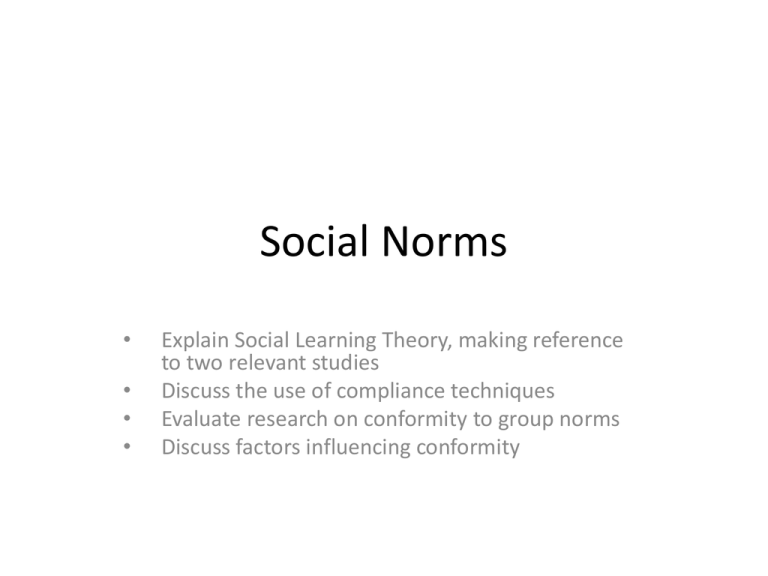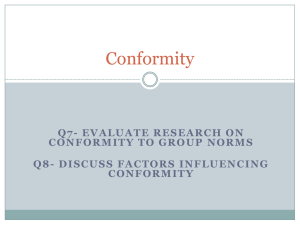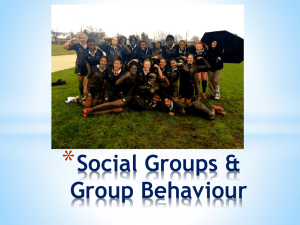Abnormal Psychology
advertisement

Social Norms • • • • Explain Social Learning Theory, making reference to two relevant studies Discuss the use of compliance techniques Evaluate research on conformity to group norms Discuss factors influencing conformity Define social norm. What do they do? • According to Smith and Mackie (2007) – a generally accepted way of thinking, feeling, or behaving that most people in a group agree on and endorse as right and proper. • Norms: – Provide for appraisal of true/false and appropriate/inappropriate – Regulate behaviours – Make social life predictable Explain observational learning. • Variant of behaviouristic learning – extended to observing others and learning from their consequences. A form of vicarious learning – we learn by imitating the behaviours of others (models) and anticipate the same consequences they elicited. • Reinforcement: – Is cognitive rather than direct – increases our ability to predict the future. – Reinforcement is not needed for learning but for the performance of what has been learned. Outline the cognitive processes involved in Social Learning Theory. • Motivation – we behave according to outcome expectancies • Attention – we focus awareness on a model and their actions and consequences. The more attractive, distinctive, or powerful the model the more we attend to them. • Coding and memory – model behaviour needs to be encoded to allow for immediate imitation or delayed imitation Give an example from your own experience of abstract modelling. • Abstract modelling – Learning of abstract skills or underlying principles that guide behaviour and consequence through observation of models. How does our sense of our effectiveness affect our motivation? What impact do you see this having on the classroom setting? • We are more motivated to behave in a given manner if we believe we will be successful or effective in gaining our anticipated outcome. We are more likely to imitate a model in a behaviour in which we anticipate we will be effective. • In a classroom setting, if a student believes that the task is beyond their capability or they anticipate poor performance, incomplete modelling will occur or motivation will decrease. Social Learning Theory • Abstract modelling, observational learning, self-efficacy, deferred imitation and vicarious reinforcement all show us how normative standards for behaviour are internalized. – Social Cognitive Theory “Our behaviour is largely regulated by our beliefs and expectancies rather than…the external environment” Do you agree or disagree with this statement? Explain your point of view referencing your personal experience and your prior knowledge from the course. • Do you sing in the shower? Do you pick your nose? Do you behave differently when you are alone? FARTS!!!! Social Learning Theory - Bandura (1965) • Type – covert observation experiment • Aims – to determine whether children will play more aggressively with a doll after observing adult models play aggressively. • Methods – In the control condition, children were shown a video of adults playing with a “Bobo” doll aggressively by throwing it around and kicking it. In the model-reward condition, the adults behaved aggressively toward the doll and a second adult entered the frame and rewarded them with a soft drink. In the model-punished condition, the adult behaved aggressively toward the doll and was scolded and spanked by another adult. • After viewing, children were taken into a second room of toys including the Bobo doll and their play was observed. • Conclusions – control and model-reward conditions resulted in equal levels of aggressive play. Model-punished condition showed significantly lower aggression. When asked to repeat the aggressive play for a reward, all children acted more aggressively. Bobo doll experiment • Demand characteristics – were the children being authentically aggressive to the doll or were they just mimicking the adult models according to the expectations of the researchers? • Internal validity – did the operational definition of aggressive play accurately reflect aggression or was this an a priori assumption • Natural validity – it’s just a doll – it doesn’t have feelings, it doesn’t cry, it doesn’t say stop Do you think the study supported the theory that aggression is a learned rather than an innate behaviour? • Do infants perform the task and grow into its meaning or do they behave according to their disposition or urge? Explain social learning theory, making reference to two relevant studies • 1) Bandura’s “Bobo” doll experiment (1965) • Aggressive play was observed and learned by children by just observing rewards and punishments. Aggressive play was elicited with expectancies of rewards. Therefore learning occurred without rewards and punishments but they were required for performance. • 2) Gergely et al (2002) • Children did not simply imitate the behaviour of the adult models (turning on the light with their , they attributed a reason to the behaviour and copied the reasoning, not just the behaviour. Conformity Sherif 1935 • To investigate the effect of group setting on responses to ambiguous situations • Participants viewed an optical illusion involving a lit object that would be stationary but appear to move. Participants made 100 judgements regarding how much the object moved. Personal norms were generated through these estimates. Participants were then asked to form group judgements by announcing their interpretations in order. The alterations in judgements were then compared and analysed. • Group estimated settled around a group norm that varied from other group norms and from the individual norms. Subsequent individual estimated reflected the new group norms. • To what extent were these authentic groups? Are these natural ambiguous settings that we would be likely to encounter in real life? Asch 1951 • To investigate the impact of group influence on conformity in unambiguous situations. • Participants were asked to compare a single line length to a set of three lines. In the control condition, participants were responding aloud and alone. In the experiment condition, participants were responding among a group of confederates who announced their responses out loud first. In 12 of the 18 group trials confederates announced incorrect responses. • Participants conformed to the wrong responses 37% of the time and 76% conformed at least once. • There are some ethical concerns with deception. Will all participants conform for the same reason? Why, if this is a powerful situational determinant, were conformant responses not 100% of the time? What would influence a participant to break from the group some of the time and not all of the time? Abrams et al. 1990 • To investigate the impact of perceived ingroup influence on conformity • Participants were asked to compare line lengths to another set of lines in groups. In one condition, the participants were told that the other group members were fellow psychology student and in the second condition, participants were told that the fellow group respondants were history of civilization students. • 100% of participants conformed at least once in the ingroup condition, 50% in the outgroup condition. • Would there be a genuine perception of ingroup sentiment from simply enrolling in the same field of study? Describe the three forms of influence on conformity identified in the reading • Informational influence - when we take another’s views as our own for the purpose of gaining evidence we perceive as valid or useful. Important for reducing ambiguity and based on our need to be right. • Normative influence – when we allow ourselves to be influenced to meet the expectations of others, avoid disapproval or rejection, and be liked by others. • Referent informational influence – when we conform out of a need to belong to important ingroups as part of maintaining our desired social identities. We conform more to groups we identify with and want to belong to. How does the study by Deutch and Girard exhibit both informational and normative influence? • College students would alter their answers and conform to the authoritative result showing informational influence • College students would lie about their unwritten answers to conform to the norm of the actual estimate How is referent informational influence different from informational and normative influence? • People conform not to other group members (normative) but to the group norm. • They use others as a source of information on what the norm is rather than the actual answer (informational). What dispositional traits are associated with higher levels of conformity? • Dispositional traits for conformity: – Low self esteem – High need for social approval – Anxiety – Perception of low status Research and give an example of ONE study showing the impact of group size on conformity. Give the author, date and conclusions of the study. • http://gpi.sagepub.com/content/8/4/331.short Define risky shift. Explain how social comparison theory and social identity theory account for this group behaviour. • Risky shift – the tendency for group decisions to be riskier than individual decisions. • Modified later into group polarization – the tendency for the group to make decisions that are more extreme than individual decisions. • Social comparison – norms are extablished in group discussions, the need for some to establish individuality causes them to want to stand out. This leads to greater ingratiation into the ingroup and further members to conform. The net effect is a more extreme norm being established. Studies controlling for group modelling of this effect have still obtained extreme norm formation which would indicate that this effect is not uniform. • SIT – in order to maximize ingroup-outgroup differentiation, category accentuation effect will cause positions to become more extreme. Research shows that norms can be polarized away from target outgroups to maintain positive distinctiveness. What are the defining characteristics of groupthink? How was the phenomenon modified in its interpretation of group cohesion? • • • • • Groupthink: High group cohesiveness Decisional urgency Need for consensus Research indicates group members share social identity rather than individual information showing that group cohesiveness was a function of group level effects rather than interpersonal liking. Social identification strengthens the effects of normative and informational influence and intensify conformity Culture and Cultural Norms Outline two definitions of culture. • Shirav and Levy, 2004 - A set of attitudes, behaviours and symbols shared by a large group of people and usually communicated from one generation to the next. • Matsumoto and Juang, 2008 - A unique meaning and information system, shared by a group and transmitted across generations, that allows the group to meet basic needs of survival, pursue happiness and well-being, and derive meaning from life Define cultural norms. How are they similar to social norms and how are they different? • Cultural norms – Norms of an established group which are transmitted across generations and regulate behaviour in accordance with the group’s beliefs about acceptable and unacceptable ways of thinking, feeling, and behaving. • They cover wider groups and form parts of larger identities. Describe the method used by Hofstede to define cultural dimensions. Do you think there are any validity issues with this method? • Thematic content analysis of survey data of workrelated attitudes of IBM employees in 72 countries. Depending on the questions asked, there could be sampling validity issues considering only one company or type of company was used as a pool of respondants. Demand characteristics could also account for uniformity of answers as the relevant culture expressed in the responses would be one of the workplace rather than the culture of the host country. Identify the five cultural dimensions according to Hofstede. Explain where you think we rank on these dimensions. • Individualism/collectivism – Individual societies define identity with personal characteristics whereas collectivist societies define identity with membership in groups (families, tribes, etc) • Power distance – the extent to which a society fosters power and status differences between individuals and encourage people to accept their place in the social hierarchy • Uncertainty avoidance – the extent to which a society accepts ambiguous situations or uncertainty or are uncomfortable and unaccepting of them. • Masculinity/femininity – Masculine societies emphasize achievement, success, and possessions as opposed to feminine societies which emphasize interpersonal harmony, caring for others, etc. • Long-term/short-term orientation – Confucian dynamism – the extent to which a culture will promote delay of gratification or will promote consumption or hedonism. How would the dimension of individualism and collectivism impact the SIT of identity? Evaluate how the textbook deals with this issue. • SIT states that our identity comes from our network of group memberships and the relationship between our group and other attended groups. Individualism/collectivism define the cultures in isolation broadly. According to the text – people in individualistic cultures will still seek out and become part of defining groups. Describe the research conducted by Petrova (2007). Do you agree with the textbook’s explanation for the results (Cialdini, 1999)? • Field experiment-experimental study • Aim – to investigate the interaction of individual/collective cultural dynamics on compliance levels • Method – 3000 US college students, half of which are Asian. All are sent an email participation request for a study. A month later, all were asked to participate in an online survey. • Results – a higher proportion of Asian students agreed to the first request but a higher proportion of US students followed through to the second request. • Cialdini hypothesized that a higher proportion of collectivist culture members would be sensitive to the actions of the group and would therefore “fall in line” with the rest if they knew who had complied in the past to requests. This was not studied as part of Petrova’s work. Summarize the impact of individualism and collectivism on compliance and conformity. • Meta-analysis of conformity studies shows that collectivist cultures showed more tendencies toward conformity in Asch paradigm studies than individualistic societies. This is consistent with the cultural dynamic of collectivism as members of collectivist societies would be more concerned with agreement and minimizing conflict rather than submitting to the will of another which would a negative idea in individualistic cultures Summarize the research by Chen (2005). How would SIT explain the results? • Chen (2005) • Aims: To investigate the prevalence of patience in long term oriented societies compared to short term societies. • Methods: 147 participants of both Singaporean and US origin were split into two groups. One viewed a collage of images related to Singaporean culture and the second group viewed images relate to US culture. Both groups were then given a decision to purchase a book with a delayed delivery or with an extra charge and an immediate delivery. • Results: participants activated by the US images valued immediate consumption by purchasing the book immediately more than Singaporean activated participants. • SIT would explain these results with the idea that the images activated perspectives of the relevant ingroup. Participants then would behave in a way which would emphasize positive distinctiveness and social comparison. Participants were able to choose either ingroup to identify with and would consciously or unconsciously act in accordance with them. Identify some extraneous variables that may confound the results in some of the research identified in this section. • It would be an assumption to link viewing images with activating a mindset of a particular culture. There are many possible variables that would factor in to the decision of a subject and other factors may account for behaviour. Participants history would be composed of other relevant events that would presumably shape behaviour. Emic and Etic Concepts Define emic and etic. How did these concepts originate? • Etic – An approach to cross-cultural analysis. Studying what all cultures have in common. Seeking universal principles of human behaviour. • Emic – An approach to single cultural examinations. Isolated to one culture’s distinctive or unique behaviour. The meaning of behaviour can only be expressed in terms of the culture of its origin. • These approaches grew out of the study of language sounds – phonetics. Using the above definitions, would you consider Hofstede’s method of defining cultural dimension emic or etic? • Hosfstede’s approach would be etic – some identified concepts are common for all cultures (time? Definition of wealth?) • defined in relation to another culture. What is the imposed etic approach? Is all research inherently etic? • Using the concepts of one culture to study another – imposed etic approach • Is it possible to explain behaviour without culture-specific approaches? – Language used to convey results and discuss – Audience of the targeted hypothesis – Purpose of doing the study to begin with How do emic and etic approached differ in their approach to depression? Give one example of research supporting each approach. • Depression – etic – Symptoms of depression are common across cultures – sadness, joylessness, anxiety, sense of insufficiency. Some symptoms were reported that were not asked as part of the diagnosis possibly due to cultural factors related to the study. Eg. WHO study of depression across four countries • Depression – emic – approach to depression would be different in different cultures. Eg. Hopi Indians – AID Scale – no word to describe depression but five illness categories. Some categories were similar to Western conceptions of depression but others were not. What effect would language have in the research and interpretation of data in cross-cultural studies? • Understanding and expression of ideas automatically involve some cultural bias in interpretation. Some sets of feelings associated with what we would call depression may not be called the same terms or expressed in the same perspective in another culture. Framing conclusions in English automatically introduces cultural perspective. Going back over the cultural dimensions – explain the behavior associated with depression according to TWO of the five dimensions. How would you guess someone with depression would behave in those cultures? • • • • • Individualism/collectivism Masculinity/femininity Power distance Risk/uncertainty avoidance Confucian dynamism • • • • Sadness Joylessness Anxiety Sense of insufficiency Methods used in the sociocultural level of analysis • Discuss how and why particular research methods are used at the sociocultural level of analysis • Discuss ethical considerations related to research studies at the sociocultural level of analysis Experiments • Egs – Jones and Harris – FAE study – Bargh et al – experimental study on automatic stereotype activation – Bandura – Bobo Doll experiment • • • • Validity is high Artificiality leads to low ecological validity Rarely are experiments taken alone – triangulation True lab experiments are not possible on cross-cultural questions • Field experiments and natural experiments are more common – Chen et al – bicultural participants Correlational studies • Egs – Hofsetde’s cultural dimensions • Relies on massive surveys - factor analysis through elaborate mathematical formluas • Individuality de-emphasized for broad cultural generalizations • Allows for more specific claims to be investigated/targeted Case studies • • • • Egs Janis – Groupthink Relies on archival research and interviews Must be seen in a group framework rather than individual behaviour • Asch and Sherif – are these group studies or case studies? Ethics • Use of deception and inducing stress: – Asch – Milgram • Evoking of stereotypes – Bargh et al. • Cross-cultural studies used as grounds/justifications for stereotyping? – Hofstedes’ cultural dimensions • Final question must be based on the value of the knowledge gained – which of the studies we have examined could be justified on these ground? What cultural biases would make one answer different from another? Choose one…/8 marks • 1. Outline TWO principles that define the sociocultural level of analysis • 2. Explain ONE error in attribution • 3. Describe ONE factor influencing conformity • 4. Explain the terms emic and etic. Choose ANOTHER one…/22 marks • 1. Evaluate social identity theory, make reference to two relevant studies • 2. Discuss research on conformity to social norms








